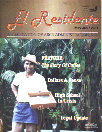 Feature Article
Feature Article
Articles from the Magazine El Residente published by ARCR Administracion SA
|
Articles from the Magazine El Residente published by ARCR Administracion SA | ||
The Story of Coffee, and Café Britt's Coffee Tour : | |
|
By |
There can be no doubt that the state animal of Costa Rica should be the billy goat, whose penchant for dietary research is reputed to have given the world the morning cup of coffee without which the dark ages would surely have carried on for another 500 years. |

In the mid 9th century A.D. goats tended by an Abyssinian named Kaldi began showing signs of extreme contentment. The inquisitive goatherder tried eating the berries from the bushes on which they had been feeding, and was so delighted by the great feeling engendered that he immediately scampered off to tell the world.
Condemned at first by both Islamic as well as Christian leaders, the confection was known as the "Devil's brew" until blessed in the Middle Ages by an enlightened Pope.
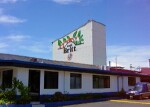
First widespread popularity was attained in London where a coffeehouse was opened in 1652, to be followed in 1688 by a shop under the proprietorship of a man named Edward Lloyd. Businessmen who began gathering at Lloyd's coffeehouse gave birth to the firm of Lloyd's Underwriters, without which the British Empire would probably have been financially unfeasible. In 1737 Merchant's CoffeeHouse opened its doors in New York where, according to authorities on the matter, the idea of the union of the United States was brewed.
The coffee bean arrived in Costa Rica in 1779 and experienced dramatic expansion after 1830. By the middle of the century coffee was king, generating the wealth necessary to encourage and promote the development of literature, theatre and the arts, thus allowing for the creation of a unique democratic society with a firm financial base.
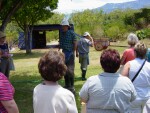
But there is much more to learn about the `golden bean.' As you sip your morning coffee have you ever wondered why some coffees have a rich flavour and others are bitter or how the fruit of the coffee plant becomes the hot drink you are savouring? These and many other questions are answered on a trip to the rolling hills between Heredia and the historic town of Barva. It is there that Steve Aronson chats with visitors and oversees the operations of a thriving business, which has been under his guidance since its infancy.
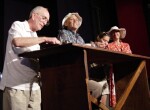
Steve Aronson was born in New York and when he was a little boy his family moved to Connecticut. It was there he met a Costa Rican family and that relationship had a great influence on the direction his life would take. He majored in Agriculture in university, which led him to Colombia to study the production of coffee and rice. He returned to the U.S. by car, which, of course, took him through Costa Rica. He stayed with his childhood Costa Rican friends and fell in love with the country and its people. Something inside told him he would return.
He spent the next several years travelling throughout South and Central America dealing mostly with the marketing aspect of coffee. One trip took him to Mexico where he met a lady from France who was teaching French there. She became his wife and joined him in his travels but after the third child was born they decided it was time to settle down. Steve's choice, of course, was Costa Rica so, with the blessing of his company, they built a home in the province of Heredia where they still live today.
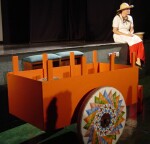
When a country exports their products it is usually the `cream of the crop' that is shipped out and the more inferior merchandise remains to be consumed by the residents. Steve noticed this was happening with coffee in Costa Rica and when he founded his own company in 1983 he decided to reverse the process. He wanted to sell `top of the line' coffee to Costarricans. Knowing they were used to their domestic coffee being less than superior, his marketing ploy was to get them to think they were drinking imported coffee. Knowing also that Scandinavians were the highest consumers of coffee in the world, he adopted a Scandinavian sounding name: Britt.
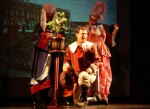
Once he had the locals consuming his `strictly hard bean' Arabic coffee he started looking farther afield. It was in 1838 that the first beneficio was built in Costa Rica. A beneficio is a processing facility, which uses a wet method of stripping the skin, bulk and husk exposing the pure coffee bean. Although, even today, most of Costa Rican coffee is exported at this stage, as the unroasted bean, Mr. Aronson took it a step farther and started roasting, grinding and shipping out the end product and has not looked back. His product line has expanded, his facilities have been upgraded in response to the demand and although Cafe Britt has gained international recognition fifty percent of his loyal customers are still Costarricans.
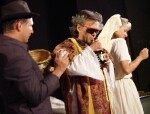
As tourists became interested in the farming and roasting of coffee, guides began asking Cafe Britt if they could bring groups to tour their farm and facilities. This worked for awhile but Steve started to think of ways to make the tour not only educational but also entertaining. He commissioned playwright Jorge Arroyo to write a script and the tour became a play. Professional actors lead the visitors through the coffee fields and the roasting facilities explaining the growth, harvesting and processing of the `golden' bean. The next step is a demonstration showing how the bean and, ultimately, the coffee is tested to ensure it meets the high standards set by the company. Then comes the stage production telling the history of the coffee industry. The costumes are elaborate and many as the story moves through the centuries. The entire tour is punctuated with humour and lively bantering which includes audience participation. The finale is a wedding with two visitors `standing up' for the bride and groom. You may ask, "How does a wedding fit into a coffee tour?" The story is long and involved with a surprise ending so there is no point in spoiling the fun by `spilling the beans' here.
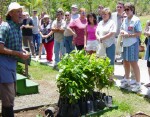
The wedding guests are then invited into the gift shop to sample the various types of coffee and to purchase any items they may wish to take home for friends and family. A typical Costarrican meal is then available in the patio restaurant, which can be enjoyed while looking out over the green coffee fields. Coffee has played such a vital part in the economic development of Costa Rica it is viewed by the people as being much more than a means of foreign exchange. It is, in fact, an integral part of the country's history and a source of national pride and identity. Steve Aronson is very sensitive to the significance of coffee in the heritage of his adopted country and is rightly proud to be a part of its continuing role in Costa Rica's future. For information call (506) 233-8068 e-mail: crtravel@casacanada.net website: www.crtravel.com
© El Residente ARCR Administración S.A. San José, Costa Rica N.B. Like all information on the internet, this article may currently be incorrect or out of date.